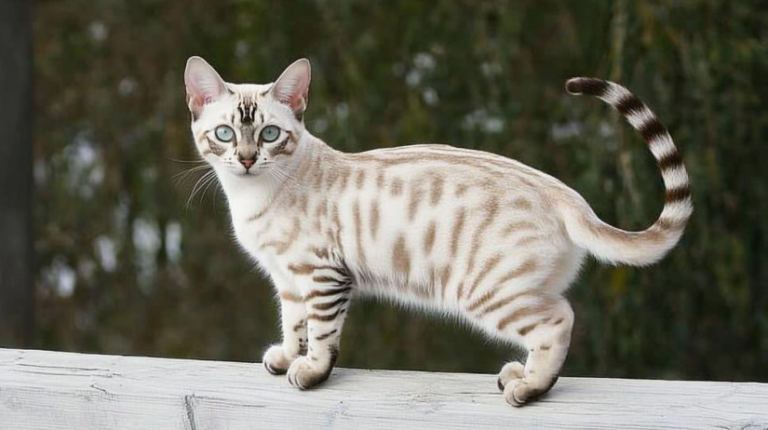Burmese Cats: What to Know About Their Loving Personality
When you enter the room, a pair of eyes meet you. They seem to look right into your heart. Burmese cats are known for their loving, dog-like nature. They have won many hearts.
These cats started with Wong Mau in 1930. Now, they are loved in many homes in the United States. They are smart, playful, and loving.
Burmese cats have short, silky fur and beautiful colors. They look elegant and charming. But what really makes them special is their loyalty and social nature.
They are perfect for those who want a loving feline friend. They fill your days with love and comfort.
If you’re thinking about getting a Burmese cat, or just interested in cats, this article is for you. We’ll explore what makes these cats so unique and special.
Here’s an overview table for the Burmese Cat:
| Attribute | Description |
|---|---|
| Official Name | Burmese Cat |
| Common Name | Burmese |
| Pet Height | 10-12 inches |
| Pet Weight | 8-15 pounds |
| Lifespan | 12-16 years |
| Smartness Level | High |
| Engagement in Play | Very High |
| Human-Friendly | Very Friendly |
| Animal-Friendly | Generally Friendly |
| Favorite Food | High-quality protein sources (chicken, fish) |
Table of Contents
Overview of Burmese Cats’ Characteristics
Burmese cats are a captivating breed known for their distinctive features and endearing personalities. They come from Burma (now Myanmar). This breed was introduced to the United States in the 1930s. They quickly became popular for being Hypoallergenic Pets and having Sleek Coats.

Origin of the Burmese Breed
The Burmese cat’s lineage starts with Wong Mau, a cat found in Burma in the 1930s. Through selective breeding, the Burmese breed was developed. They have a muscular body, rounded head, and striking gold eyes.
Physical Appearance and Features
Burmese cats come in various captivating colors, including sable, champagne, platinum, and blue. They have a Sleek Coat that is short, glossy, and easy to maintain. They weigh 8-12 pounds and are 8-10 inches tall. They have a well-proportioned, muscular build.
Typical Size and Weight
A typical Burmese cat weighs between 8 and 12 pounds. Females are generally smaller than males. They can stand up to 12 inches tall. With proper care, they live 12 to 16 years.
The Affectionate Nature of Burmese Cats
Burmese cats are known for their Devoted Companions nature. They keep a playful spirit even as adults. They enjoy playing and connecting with their families.
Their Playful Attitude
Burmese cats are famous for their Playful Personalities. They chase toys and climb with endless energy. They are smart and curious, always ready to learn.
Bonding with Owners
Burmese cats are very affectionate and social. They act like dogs, always by their owner’s side. They show love through purring, meowing, and cuddling. This bond can make everyone feel better.
| Burmese Cat Traits | Description |
|---|---|
| Playful Personality | Burmese cats maintain a kitten-like enthusiasm and curiosity throughout their lives, enjoying interactive play and learning new tricks. |
| Affectionate Nature | These cats form strong, loyal bonds with their owners, often following them around and seeking physical affection through purring and cuddling. |
| Vocal Communication | Burmese cats are known for their expressive vocalizations, using soft, sweet meows and purrs to “converse” with their human companions. |

“Burmese cats are the perfect blend of playful personality and devoted companionship. They bring endless joy and laughter to their owners’ lives.”
Caring for Your Burmese Cat
Burmese cats are known for their loving nature and low-shedding coats. They are a favorite among pet owners. To keep your Burmese cat happy, it’s key to know their special diet and grooming needs.
Nutritional Needs and Diet
Burmese cats are full of energy and need a diet rich in protein. A mix of high-quality dry and wet food is best. This makes sure they get all essential nutrients they need.
Grooming Requirements
Burmese cats have a short, fine coat that needs little grooming. They are low-shedding cats, which is great for those with allergies. Just a weekly brush with a rubber brush keeps their coat shiny and removes loose hair.
- Burmese cats shed very little, making them easy to groom.
- They only need a weekly brush to keep their coat looking good.
- Take care of their nails and ears regularly.
By understanding and meeting your Burmese cat’s unique needs, you can ensure they are happy and healthy. They’ll become a wonderful part of your home.
Behavioral Traits of Burmese Cats
Burmese cats are known for being Intelligent Companions and having Playful Personalities. They make great and fun pets. These cats love being around people and form strong bonds with their owners.
They’re friendly also with other pets, including dogs. They enjoy playing together and having fun.
Socialization with Other Pets
Burmese cats are very friendly and usually get along with other pets. They are less likely to fight with other cats than some breeds. They can even live with dogs if introduced slowly and carefully.
Interactive Playtime Ideas
- Fetch: Burmese cats can learn to play fetch, chasing and bringing back small toys or balls.
- Tag: They love playing tag, running and jumping around the house.
- Puzzle Toys: They enjoy solving puzzles that give them treats.
- Climbing Perches: They like to climb high to see what’s going on.
Burmese cats are curious and love to play. Regular play helps them stay healthy and happy. It also keeps their minds and bodies active.
Health Considerations for Burmese Cats
Burmese cats, like any other breed, have health concerns that owners need to know. They are generally healthy but can face certain genetic issues. These need careful watching and vet care.

Common Health Issues
Some health problems Burmese cats might get include:
- Feline asthma, affecting up to 5% of cats, hitting Burmese cats more often
- Chronic renal failure, impacting up to 5% of cats’ kidneys
- Inflammatory bowel disease, causing chronic vomiting, diarrhea, and weight loss
- Diabetes mellitus, leading to excessive thirst, urination, and weight loss
- Hypokalemic polymyopathy, an inherited muscle weakness
- Congenital and acquired heart diseases, including cardiomyopathy
- Burmese Head Deformity, causing skull and jaw malformations
- Pica, the urge to eat non-food items like fabric
- Gangliosidosis, a neurological condition leading to early death
- Endocardial Fibroelastosis, a genetic heart failure risk
Regular Veterinary Check-ups
Regular vet visits are key for Burmese cats’ health. Your vet can do tests like DNA screening to spot genetic issues. Early care and action can manage these risks and keep your Burmese cat healthy and happy.
“Regular vet visits are essential for responsible Burmese cat ownership to spot health issues early.”
Training and Obedience
Burmese cats are very smart and easy to train. They can learn simple and complex tricks. Using positive methods like clicker training works best for them.
Basic Commands Every Cat Should Know
- Sit
- Come
- Stay
- High-Five
- Fetch
Teaching your Burmese cat these commands can make your bond stronger. It also shows off their skills to others.
Litter Box Training Tips
Burmese cats are easy to train for the litter box. They like to be clean and please you. Keep the litter box clean and consistent.
Start training early and reward them for good behavior. This makes training easier.
| Breed | Trainability | Socialization Needs | Recommended Training Methods |
|---|---|---|---|
| Burmese | Highly trainable | Early socialization is crucial | Positive reinforcement, clicker training |
| Ragdoll | Moderate trainability | Gentle socialization from a young age | Positive reinforcement, patience-based methods |
| Maine Coon | Highly intelligent, responsive to training | Socialization during kitten-hood for best results | Interactive training sessions, clicker training |
Knowing how to train different cat breeds helps a lot. It ensures your Burmese cat gets the best training.
Understanding Burmese Cat Communication
Burmese cats are known for their soft, sweet voices. They enjoy “conversing” with their devoted companions. They use various vocalizations to communicate their needs or express their moods.
From gentle meows to playful chirps, their expressive sounds can provide valuable insights into their emotional state.
Vocalizations and Their Meanings
Burmese cats have a wide range of vocalizations in their repertoire. A soft, almost purr-like meow often indicates contentment. A higher-pitched meow may signify a request for attention or food.
These cats may also emit a distinctive “chirp” when they’re excited or engaged in playtime. Understanding the nuances of your Burmese cat’s vocalizations can help you better address their needs and strengthen your bond.
Body Language Insights
In addition to their vocal cues, Burmese cats use their body language to convey their emotions and intentions. A slowly swishing tail may indicate curiosity or mild irritation. A quickly twitching tail often signals a playful or energetic mood.
The position of their ears, whether perked up or laid back, can also provide valuable insights into their state of mind. By observing your Burmese cat’s body language, you can gain a deeper understanding of their unique personality and preferences.
Mastering the art of interpreting your Burmese cat’s vocalizations and body language can deepen the bond you share with your devoted companion. By tuning in to their subtle cues, you can better meet their needs, provide them with the affection they crave, and enjoy the rewarding experience of owning a Burmese cat.
The Ideal Living Environment for Burmese Cats
Burmese cats are known for their playful personalities and sleek coats. They make great companions. To help them thrive, they need a special environment.
Best Home Conditions
Burmese cats do well in homes where they get lots of attention. They love to climb, jump, and explore. So, they need cat trees, window perches, and multi-level structures. Keeping them inside helps keep them safe.
Enrichment Activities to Consider
- Puzzle feeders that challenge their problem-solving skills
- Interactive toys like wands and laser pointers to stimulate their natural hunting instincts
- Scheduled play sessions with their owners to promote bonding and exercise
- Rotating selection of new toys to prevent boredom and maintain their interest
Creating a stimulating and safe space is key. This way, your Burmese cat’s mind and body will stay healthy. Their playful nature and sleek coats will flourish.
| Ideal Home Conditions for Burmese Cats | Recommended Enrichment Activities |
|---|---|
|
|
Burmese Cats and Children
Burmese cats are known for being sweet and playful. They’re awesome companions for homes with kids. These Devoted Companions among the Feline Breeds love to play and are very patient, making them perfect for kids.
How They Interact with Kids
Burmese cats get along well with children and love to play together. They’re known as “lap cats” because they love snuggles. But, it’s key to teach kids how to handle them gently and with respect.
Teaching Kids to Respect Cats
- Tell kids to move calmly around the cat and avoid loud noises or sudden movements.
- Show them how to pet the cat gently, like stroking its back or chin, not pulling its fur or tail.
- Teach them not to wake the cat when it’s sleeping or eating, as it can get upset.
- Make sure kids ask before touching the cat and watch them to keep everyone safe.
By teaching kids to be gentle and respectful, families can create a loving bond between their Devoted Companions and children.
Comparing Burmese Cats to Other Breeds
Burmese cats are part of the Feline Breeds family. They share similarities and differences with breeds like Siamese and Tonkinese cats. Knowing these can help you choose the right Intelligent Companions for your home.
Burmese vs. Siamese Cats
Burmese and Siamese cats are both smart and talkative. But, they differ in some ways. Siamese cats are more vocal and need more attention. Burmese cats are more cuddly and affectionate.
Siamese cats have a sleek body and short fur. Burmese cats have a muscular build and soft fur. Health-wise, Siamese cats might get sick more often, especially with breathing and eye problems. Burmese cats can get fat and have heart and face issues.
Similarities to Tonkinese Cats
Burmese cats are similar to Tonkinese cats. Tonkinese cats combine traits from Burmese and Siamese breeds. Both are friendly, easy to train, and have a sturdy build.
Tonkinese cats look like a mix of Burmese and Siamese cats. They share many traits with Burmese cats. This makes them a good comparison.
| Breed Comparison | Burmese Cats | Siamese Cats | Tonkinese Cats |
|---|---|---|---|
| Appearance | Muscular, medium-sized, plush coat | Sleek, slender, short coat | Blend of Burmese and Siamese features |
| Temperament | Affectionate, cuddly | Vocal, demanding of attention | Affectionate, trainable |
| Health Considerations | Prone to obesity, HCM, craniofacial defects | Respiratory issues, eye problems | Potential for health issues from both parent breeds |
Understanding the differences between Burmese cats and other breeds helps you choose the right Intelligent Companions. This ensures they fit well with your lifestyle and preferences.
Resources for Burmese Cat Owners
If you own a Burmese cat, you’re in luck. There are many resources to help you care for your pet. You can find books, guides, online communities, and support groups. They all aim to keep your Burmese cat healthy and happy.
Recommended Books and Guides
For a better understanding of Burmese cats, check out “The Burmese Cat” by Corinne Holt Sawyer and “Burmese Cats” by Juliette Cunliffe. These books cover the breed’s history, looks, and special care needs. The National Alliance of Burmese Breeders’ website also has lots of helpful information for owners.
Online Communities and Support Groups
Thanks to the internet, it’s easy for Burmese cat owners to connect. Sites like the Burmese Cat Club and social media groups are great for sharing. You can ask questions, get advice, and celebrate the joys of owning a Burmese cat.







